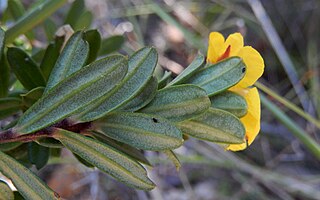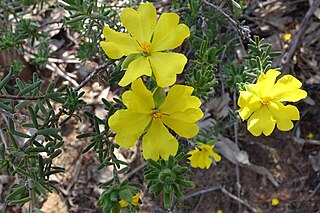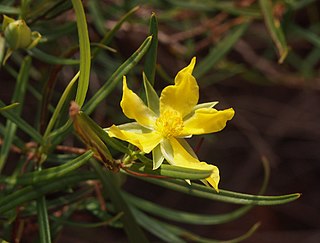
Hibbertia empetrifolia, commonly known as trailing guinea-flower, is a species of flowering plant in the family Dilleniaceae and is endemic to south-eastern Australia. It is a low-lying to spreading shrub with wiry stems, oblong to lance-shaped leaves with the narrower end towards the base, and pale to bright yellow flowers arranged on the ends of branchlets, with five to nine stamens arranged on one side of the two carpels.

Hibbertia vestita, commonly known as hairy guinea-flower, is a species of flowering plant in the family Dilleniaceae and is endemic to eastern Australia. It is a small shrub with foliage covered with simple hairs, usually linear leaves, and yellow flowers with 22 to 43 stamens with many staminodes arranged around three hairy carpels.
Hibbertia marginata, commonly known as bordered guinea flower, is a species of flowering plant in the family Dilleniaceae and is endemic to the North Coast of New South Wales. It is a spreading shrub with hairy young branches, oblong to lance-shaped leaves and yellow flowers with thirty to forty stamens and many staminodes arranged around three hairy carpels.

Hibbertia bracteata is a species of flowering plant, in the family Dilleniaceae and is endemic to eastern New South Wales. It is a shrub with lance-shaped to oblong leaves and yellow flowers with about sixteen stamens arranged on one side of the two carpels.

Hibbertia acuminata is a species of flowering plant in the family Dilleniaceae and is endemic to eastern Australia. It is an erect shrub with lance-shaped to egg-shaped, stem-clasping leaves and yellow flowers arranged singly in leaf axils with about forty stamens surrounding the carpels.

Hibbertia brevipedunculata is a species of flowering plant in the family Dilleniaceae and is endemic to northern Australia. It grows as a sub-shrub with hairy foliage, linear to lance-shaped leaves with the narrow end towards the base, and yellow flowers arranged singly on the ends of branches or short side shoots, with thirty to forty-four stamens arranged in bundles around the two carpels.

Hibbertia circumdans is a species of flowering plant in the family Dilleniaceae and is endemic to New South Wales. It is an erect shrub with hairy branches, linear to wedge-shaped or spatula-shaped leaves, and yellow flowers arranged on short side shoots, with fifteen to thirty stamens arranged in groups around the three carpels.
Hibbertia cistifolia is a species of flowering plant in the family Dilleniaceae and is endemic to northern Australia. It is a prostrate to low-lying sub-shrub with trailing, wiry stems, hairy foliage, oblong to elliptic leaves and yellow flowers arranged in leaf axils, with forty to fifty-eight stamens arranged around the two carpels.

Hibbertia covenyana is a species of flowering plant in the family Dilleniaceae and is endemic to New South Wales. It is an erect or semi-prostrate shrub with hairy foliage, oblong leaves and yellow flowers with seven to ten stamens arranged on one side of the two carpels.
Hibbertia florida is a species of flowering plant in the family Dilleniaceae and is endemic to New South Wales. It is a small shrub with oblong to lance-shaped leaves and yellow flowers arranged on the ends of branchlets, with twelve to twenty-eight stamens arranged around three carpels.

Hibbertia fruticosa is a species of flowering plant in the family Dilleniaceae and is endemic to New South Wales. It is a woody shrub with linear to lance-shaped leaves and yellow flowers arranged singly on the ends of short side shoots, with eighteen to thirty-five stamens arranged around three carpels.

Hibbertia glaberrima is a species of flowering plant in the family Dilleniaceae and is endemic to Central Australia. It is a glabrous, spreading shrub with oblong to lance-shaped leaves and yellow flowers borne singly in upper leaf axils, with 30 to 150 stamens arranged around three carpels.

Hibbertia melhanioides is a species of flowering plant in the family Dilleniaceae and is endemic to north Queensland. It is a shrub with hairy foliage, oblong to elliptic or lance-shaped leaves, and yellow flowers with more than about 25 to 30 stamens and up to eight staminodes arranged around three carpels.
Hibbertia mollis is a species of flowering plant in the family Dilleniaceae and is endemic to a restricted part of Western Australia. It is a shrub with hairy, ridged branches, narrow elliptic-oblong leaves, and yellow flowers arranged singly in leaf axils with about twenty-four stamens arranged in bundles around two densely scaly carpels.
Hibbertia pachynemidium is a species of flowering plant in the family Dilleniaceae, and is endemic to southern New South Wales. It is a small, mat-forming shrub with oblong to lance-shaped or elliptic leaves and yellow flowers with eight to seventeen stamens arranged around three carpels.

Hibbertia patens is a species of flowering plant in the family Dilleniaceae and is endemic to south-eastern Queensland. It is a much-branched shrub with hairy foliage, linear to oblong leaves, and yellow flowers arranged singly in leaf axils with 12 to 26 stamens arranged around two carpels.
Hibbertia reticulata is a species of flowering plant in the family Dilleniaceae and is endemic to north Queensland. It is a shrub with spreading branches, egg-shaped leaves with the narrower end towards the base, and yellow flowers arranged singly in leaf axils, with 32 to 48 stamens arranged in two or three groups around the two densely hairy carpels.
Hibbertia simulans is a species of flowering plant in the family Dilleniaceae and is endemic to New South Wales. It is a much-branched shrub with softly-hairy foliage, linear leaves and yellow flowers with eight to ten stamens on one side of two hairy carpels.

Hibbertia villosa is a species of flowering plant in the family Dilleniaceae and is endemic to northern New South Wales. It is an erect shrub with hairy branches and leaves, spatula-shaped to narrow egg-shaped leaves with the narrower end towards the base and yellow flowers with fifteen to twenty stamens in three groups arranged around three carpels.
Hibbertia singularis is a species of flowering plant in the family Dilleniaceae and is endemic to New South Wales. It is a small, low-lying shrub with many stems, oblong leaves and single yellow flowers on the ends of main branches, with 22 to 25 stamens around three carpels.












